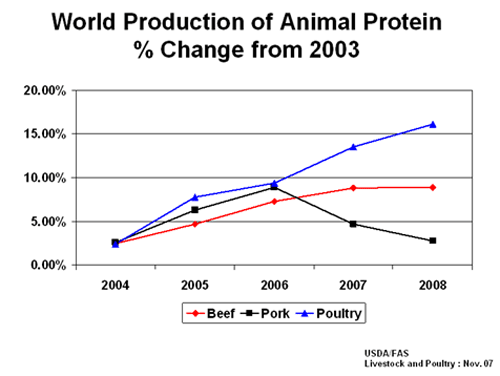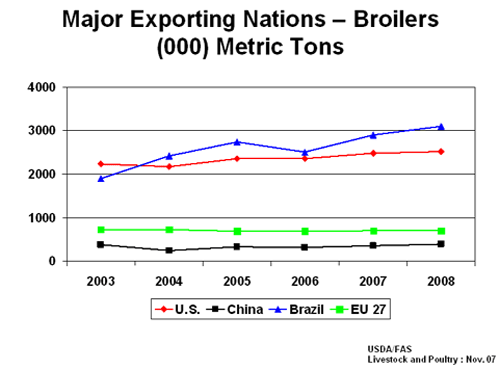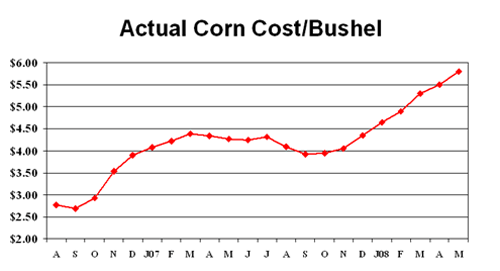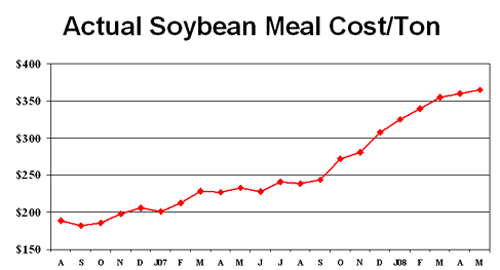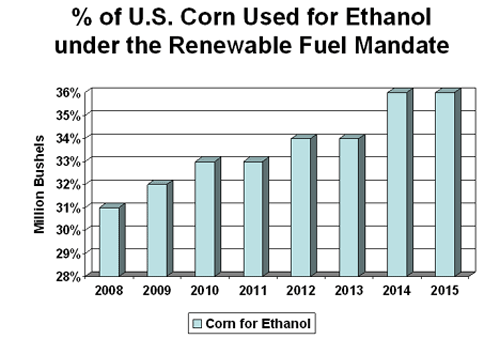However, according to research analyst Mike Donohue, vice president of Agri Stats, a management reporting and benchmarking firm based in Fort Wayne, Indiana the poultry industry in the US also faces strong challenges from the cost of feed ingredients, environmental issues and consumer demands.
"We (chicken producers) are an industry that is in demand. We've got a product that people want and continue to consume," said Mr Donohue.
"We've got efficiencies of scale, and we make tremendous genetic changes and production changes year in and year out that other industries can't do."
Chicken, beef, and pork production worldwide have all risen over the past five years, although pork production appears to have peaked and dropped slightly.
Despite a shift in the countries where broilers are produced, the United States remains the largest producer with 17 million tonnes followed by China, Brazil, with 11 million tonnes each and the European Union, with eight million tonnes, where production has remained flat, Mr Donohue said.
These four producers account for about 73 per cent of the world's broilers, with the US holding about 27 per cent of global production while the EU has seen its share drop from 14 per cent to 12.5 per cent. This, Mr Donohue said, indicates ongoing consolidation and concentration.
The US is also one of the top four exporters but is not heavily dependent on any single market. This gives it an advantage giving the country more stability in its export business, Mr Donohue said in an address at the International Poultry Expo, sponsored by the U.S. Poultry & Egg Association.
Brazil has taken over from the US as the leading exporter with exports rising from 1.8 million tonnes to more than 3 million tonnes in the last five years. Brazil now has 40 per cent of total world exports in poultry meat, while the US has 33 per cent.
One of the major changes in the export market in recent years has been the development of more higher value cuts going to China. And one of the major factors that has affected exports from the US has been the changes in exchange rates.
Mr Donohue said that as standards of living improve and economies grow, the type of meat imports, that the developing countries are taking, changes. They start taking in more and more higher value cuts.
On the import side, Russia ranks number one with imports of 1.2 million tonnes, despite an increase in its domestic production. Japan is the second leading importer, with 750,000 tonnes and China is third with 500,000 tonnes.
"Per capita consumption shows that there's still the opportunity for tremendous growth in demand for chicken products," Mr Donohue said.
The United States leads all countries in consumption at about 45 kilograms per capita, followed by Brazil at about 40 kg, Mexico 25 to 30 kg, Russia 15 to 20 kg, Thailand 10 to 12, and China 7 to 8 kg. The market in China has substantial potential for growth in consumption as consumers increasingly buy leg quarters and other products as well as more traditional commodities such as wing tips and claws, Mr Donohue said.
Turkey producers also have an opportunity to increase exports and consumption of their products.
However, the forecast is not completely sunny, Mr Donohue warned.
The US poultry industry also faces enormous and complex challenges, including the rising cost of feed ingredients, environmental issues, bird health and pandemic diseases, and sometimes unpredictable preferences and demands of consumers.
Feed costs have always been a significant issue in the poultry industry, and that has especially been the case over the past year, Mr Donohue said. Costs have been rising steadily, and he predicted that the cost per bushel of corn could reach $5.65 to $5.75 by May. He said that the cost of feed is forecast to reach 69 per cent of the production costs of broilers this year and 72 per cent for turkeys.
"This is a new paradigm we're looking at because of the nation's energy policy," he added.
The cost of soybean meal is also on the upswing, and the price per ton could soon approach $400. The average live production cost of broilers recently surpassed 35 cents and could easily reach 38 to 40 cents in the next few months with little prospect of relief.
The renewable fuels mandate within the federal government's energy policy will have an impact on the poultry industry for years to come, Mr Donohue predicted.
By the year 2015, about 36 per cent of the nation's corn production could be earmarked for ethanol production, even with an anticipated increase in volume tied to the demand for biofuels.
The percentage of corn used for ethanol has tripled in the past few years and will continue to increase.
This surge in demand also means that millions more acres will be needed to produce additional corn. It is unclear, however, where this land will come from or whether production of other crops will be affected.
Consumer preferences also will continue to impact the industry, and one uncertainty involves chicken raised without antibiotics.
Demand is growing in some sectors, but it is unclear how this trend will evolve or how growers should respond to the challenge, Mr Donohue said.
Consumers are also concerned about stunning methods and humane conditions on poultry farms, and the industry may need to do a better job of conveying the message to the public that it is responsive and shares their concerns, he added.
February 2008




